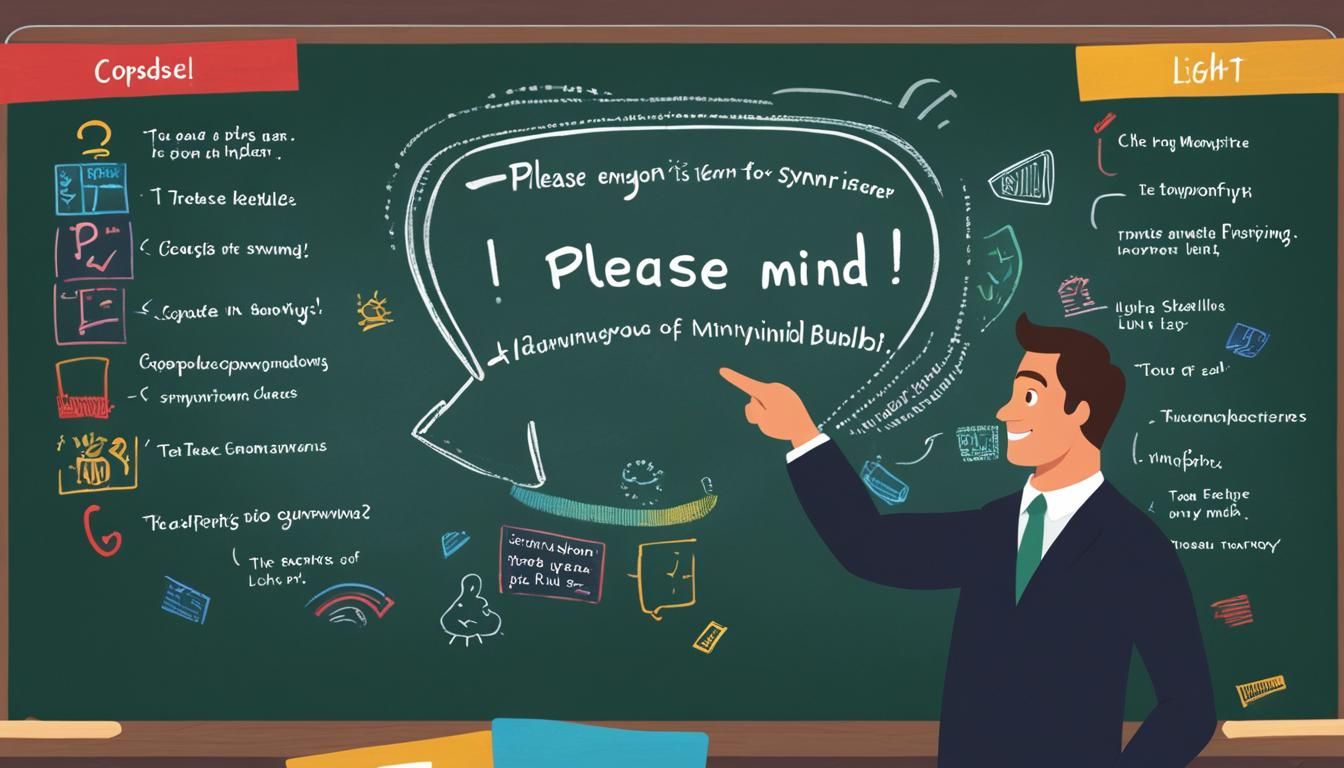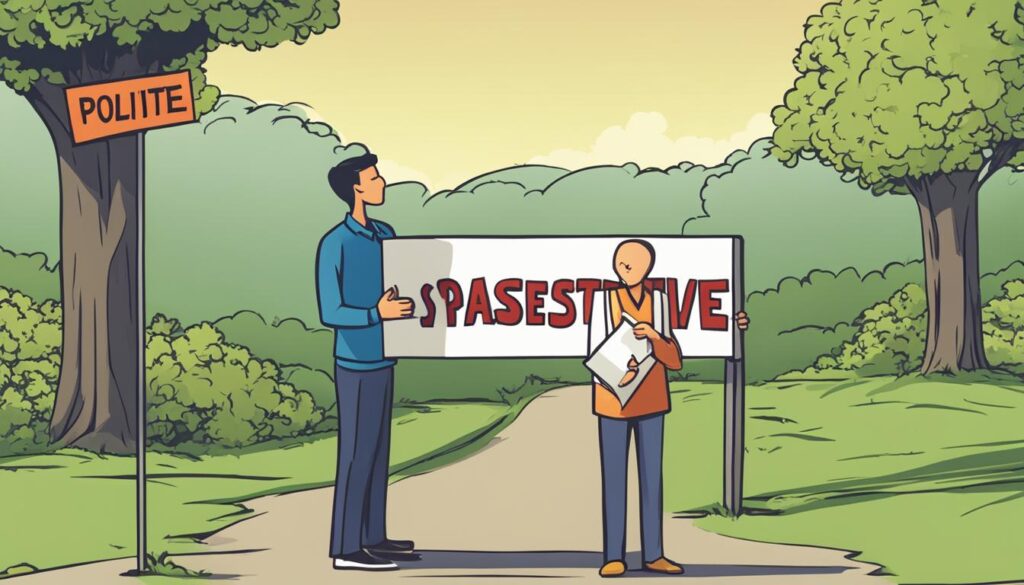When making a request for consideration, it’s important to use language that is both polite and effective. Instead of using the phrase ‘Please keep in mind,’ there are various alternative expressions that can enrich your language and eloquence. These alternatives can help you convey your message in a more poetic and persuasive manner. By utilizing different phrases and synonyms, you can politely request others to take something into account without sounding repetitive or demanding. Let’s explore some creative ways to phrase your requests.
When submitting a prompt or making a polite request, it’s essential to consider different expressions for ‘bear in mind’ or ‘keep in consideration.’ By using diverse and engaging language, you can capture the attention of the recipient and emphasize the importance of your request.
Within this article, I’ll share a range of synonyms for ‘keep in consideration’ and discuss alternative phrases for ‘please remember’. These linguistic variations will help you express your request thoughtfully and stand out in your communications.
Swapping Passive Language in Emails
When crafting emails, it’s important to be aware of the language we use, as it can greatly impact how our message is perceived. Many emails tend to rely on passive phrases, which can unintentionally convey a sense of submission or deference. To ensure our emails are assertive, impactful, and reflect our true intentions, it’s advisable to swap passive language with more direct wording or even omit it altogether.
Avoiding submissive wording not only helps us practice writing with authority, but also allows us to strike a balance between politeness and assertiveness. By finding the right blend of these two elements, we can effectively convey our message while maintaining respectful communication.
In order to swap passive language with assertive alternatives, consider the following tips:
- Use active voice: Instead of saying “The report will be submitted by me,” say “I will submit the report.”
- Remove unnecessary qualifiers: Instead of saying “I just wanted to ask,” simply state “I have a question.”
- Focus on the action: Instead of saying “It would be appreciated if you could,” say “Please.”
- Be direct: Instead of saying “I was wondering if you could,” say “Could you?”
By practicing assertive writing in our emails, we can effectively convey our intentions, establish our authority, and engage in productive communication. It’s important to remember that being assertive doesn’t mean being impolite or disrespectful. Instead, it enables us to express ourselves clearly and confidently, ultimately strengthening our professional relationships.
“Assertive language allows us to communicate our expectations clearly while maintaining respect for others.”
The Power of Assertive Writing
Assertive writing empowers us to make our point confidently and effectively. By using direct language and active voice, we can eliminate ambiguity and ensure our message is understood as intended. Writing assertively also helps us cultivate a strong professional image, showcasing our leadership skills and abilities.
While it’s important to balance assertiveness with politeness, we can achieve this by paying attention to our tone and choosing words that convey our message assertively without sounding aggressive or demanding.
Passive Language vs. Assertive Language
| Passive Language | Assertive Language |
|---|---|
| “It would be great if you could let me know.” | “Please inform me.” |
| “I was wondering if you could possibly send me the information.” | “Could you please send me the information?” |
| “If it’s not too much trouble, could you possibly give me a call?” | “Please give me a call.” |
By swapping passive language with assertive alternatives, we create more compelling and effective emails, allowing us to communicate with confidence, authority, and respect. It’s a skill worth practicing and refining, as it can significantly enhance our professional communication.
Determining Politeness vs. Passivity
When it comes to communication, determining the line between politeness and passivity is essential. Politeness involves being respectful and considerate of others, while passivity can stem from the need to please or impress excessively. It is crucial to discern the difference and strike the right balance in our language.
Politeness emphasizes respect for someone’s time, needs, and opinions. It entails expressing oneself in a manner that is considerate and tactful, without being overly solicitous. By understanding the intention behind our phrases, we can ensure that our language is respectful and genuine.
On the other hand, passivity arises from a fear of appearing too assertive or imposing. It can manifest in an excessive use of apologies, hesitancy in making requests, or constantly seeking validation. While the intention to please is driven by good intentions, it can undermine one’s voice and diminish personal power.
To discern whether our language leans towards politeness or passivity, we must evaluate the underlying intentions. Politeness prioritizes mutual respect, clear communication, and a genuine desire to understand and be understood. Passivity, however, may stem from a need for approval and a fear of conflict.
By honing our awareness of the intentions behind our phrases, we can strike the delicate balance between being respectful and assertive. It is crucial to communicate with clarity, maintain our authenticity, and respect both our own needs and the needs of others. Empowering ourselves to express our opinions and make requests without excessive solicitation allows us to uphold our voice, while still being polite and respectful.
Comparing Politeness and Passivity
| Politeness | Passivity |
|---|---|
| Expressing gratitude and appreciation | Apologizing excessively |
| Using clear and direct language | Hesitating to make requests |
| Respecting others’ time and needs | Constantly seeking validation |
| Being tactful and considerate | Fear of conflict or disagreement |
| Efficient and effective communication | Diminishing personal power |
Alternative Phrases to Replace ‘Sorry to Bug You’
When it comes to initiating email conversations, expressing gratitude and making a request can be done in a more effective and eloquent manner. Instead of starting your message with the apologetic phrase ‘Sorry to bug you,’ there are alternative ways to convey your gratitude and get straight to the point of your request. By omitting unnecessary phrases and focusing on the purpose of your email, you can maintain a respectful tone while delivering a concise and impactful message.
Consider using phrases such as “Thank you for your time/consideration/attention,” which express gratitude right from the start. This simple act of appreciation not only sets a positive tone for the conversation but also shows respect for the recipient’s valuable time and attention.
Another approach is to eliminate the introductory apology altogether and dive straight into your request. By getting to the point without gratuitous language, you demonstrate professionalism and efficiency in your communication. For instance, you can begin your email with a direct statement like “I appreciate your expertise on [topic] and would love to seek your advice on…“. This approach immediately focuses on the purpose of your email while maintaining a polite tone.
Remember, the key is to express gratitude and make your request in a concise and respectful manner. By replacing the apologetic phrase ‘Sorry to bug you,’ with alternative phrases or omitting it altogether, you can create emails that are impactful, respectful, and get straight to the heart of your message.
Replacing ‘I Was Wondering If…’ with More Direct Language
When seeking opinions or information via email, it’s essential to use language that is direct and avoids ambiguity. Instead of starting your request with the hesitant phrase ‘I was wondering if,’ consider using more assertive and confident alternatives. By choosing the right words, you can engage the recipient and encourage meaningful responses.
One effective alternative is to use phrases like “What are your thoughts on…” or “I’m writing to see if…”. These phrases convey a clear purpose and intention, eliminating any uncertainty. They demonstrate confidence and position you as someone who values the recipient’s opinion.
What are your thoughts on implementing a new marketing strategy for our upcoming campaign?
By being explicit about your objective, you create an open space for discussion. This direct approach fosters engagement and encourages the recipient to share their insights and ideas.
Moreover, using more direct language shows that you respect the recipient’s time. It allows them to understand your request quickly, without the need for extra clarifications or back-and-forth exchanges.
Overall, replacing ‘I was wondering if’ with clear, direct language in your emails enhances communication and increases the likelihood of receiving valuable opinions and information.
| Phrase | Description |
|---|---|
| What are your thoughts on… | Asking for opinions or ideas |
| I’m writing to see if… | Seeking specific information or clarification |
Avoiding Passive Language with ‘Does That Make Sense?’
When crafting emails or engaging in any written communication, it’s important to encourage active dialogue and seek clarification instead of relying on passive language. Rather than using the question “Does that make sense?”, which can be perceived as passive and hesitant, there are alternative phrases that can foster a more engaging and open conversation.
“Please let me know if you have any questions.”
This simple phrase invites the recipient to seek additional information or clarification, creating an opportunity for active communication. By promoting a culture of asking questions, you are establishing a space for open dialogue and collaborative problem-solving.
Active communication is key to ensuring that your message is clearly understood. By actively seeking clarification and addressing any potential concerns upfront, you can avoid misunderstandings and improve the overall effectiveness of your communication.
Encouraging Questions and Seeking Clarification
Instead of assuming that everything is clear, actively encourage your recipients to ask questions or seek further explanation when needed. By doing so, you not only ensure that your message is understood but also create a sense of trust and openness. Consider using phrases such as:
- Feel free to ask any questions you may have.
- I’m here to provide further explanation if needed.
- Please don’t hesitate to reach out if anything requires further clarification.
These alternative phrases empower recipients to seek clarification without feeling hesitant or unsure. It establishes a proactive and collaborative environment where all parties are encouraged to actively engage and participate in the conversation.
Fostering Active Communication
In addition to seeking clarification, it’s essential to actively foster dialogue and encourage engagement. By promoting an environment of active communication, you can cultivate stronger relationships and ensure that everyone involved is on the same page. Consider incorporating the following techniques into your written communication:
- Ask open-ended questions to prompt meaningful discussion.
- Provide opportunities for feedback and suggestions.
- Offer alternate viewpoints and respectfully challenge assumptions.
By utilizing these strategies, you demonstrate your commitment to active communication and collaboration. This fosters a sense of trust and encourages others to actively contribute their thoughts and ideas, creating a more inclusive and effective dialogue.
Summary
When ending your emails or any written communication, it is crucial to avoid passive language such as “Does that make sense?” and instead encourage active dialogue and seek clarification. By using alternative phrases that invite questions and create an environment of open communication, you can ensure that your message is understood and foster stronger relationships with your recipients.
Politely Requesting with ‘If It’s Not Too Much Trouble’
When it comes to making polite requests, it’s essential to use language that conveys your needs without sounding hesitant or burdensome. Instead of resorting to the phrase ‘If it’s not too much trouble,’ we can employ alternative expressions that clearly express our requests while maintaining a respectful tone.
One effective alternative is to use the phrase “Could you please…” followed by a concise and specific statement of what you need. By using this phrasing, you politely and assertively communicate your request without creating any ambiguity. For example, instead of saying, “If it’s not too much trouble, could you send me the report by the end of the day?” you could say, “Could you please send me the report by the end of the day?” This direct approach conveys your expectations clearly and eliminates any uncertainty.
In situations where you need someone to assist you, instead of saying, “If it’s not too much trouble, could you help me with this task?” you can say, “Could you please assist me with this task?” This simple adjustment maintains politeness while clearly expressing your request for help.
Using more direct language allows you to express your needs with confidence, while still being considerate of the other person’s time and capacity. By avoiding hesitant phrases and clearly stating your requests, you create a stronger message that is more likely to elicit a positive response.
Remember, it’s important to be polite and respectful in your requests, but being clear and direct can help ensure your needs are met in a timely manner.
Using alternative phrases to ‘if it’s not too much trouble’ empowers you to express your requests clearly, maintaining a polite and engaging tone in your communication.
Now, let’s take a look at a table that summarizes some alternative phrases to replace ‘if it’s not too much trouble’ in different contexts:
| Situation | Alternative Phrase |
|---|---|
| Requesting a favor | “Could you please…” |
| Asking for assistance | “Could you kindly help me with…” |
| Requesting information | “Would you mind sharing…” |
| Seeking feedback | “Could I trouble you for your thoughts on…” |
This table provides a handy reference for politely phrasing your requests in various scenarios, without resorting to the phrase ‘if it’s not too much trouble.’
Requesting Updates with Alternative Phrases
When it comes to seeking updates or checking on progress, there are more effective ways to communicate your needs than using the phrase “Would it be possible to…?” By opting for more specific language and clarifying deadlines or potential issues, you can maintain open communication and ensure that tasks are completed on time.
Instead of using a generic phrase, consider asking for updates by providing clear instructions or asking specific questions. Rather than simply asking “Would it be possible to provide an update on the project?” you can be more direct and ask “When can I expect the project to be completed?” or “Are there any obstacles that might affect the timeline?” This not only shows your proactive approach but also helps to set clear expectations.
Remember, maintaining open communication is key. By expressing your interest in regular updates and maintaining a collaborative spirit, you can foster effective two-way communication where both parties feel comfortable sharing information and asking questions.
“Effective communication is the bridge that connects progress and success.”
Benefits of Clear Communication
- Ensure tasks are completed on time
- Maintain open dialogue and collaboration
- Address any potential issues or delays promptly
- Set clear expectations for both parties
By using alternative phrases to request updates and maintaining open communication, you can foster a productive working relationship and ensure that everyone is on the same page. Remember, clear and proactive communication is the key to success.
Ending Emails with ‘Let Me Know!’
A well-crafted email not only conveys your message effectively but also sets clear expectations for the recipient. Rather than ending your emails with the common phrase ‘Let me know,’ there are alternative ways to express your needs while promoting proactive communication.
When requesting information or confirmation, it’s important to provide specific instructions and indicate deadlines. By doing so, you create a sense of urgency and increase the likelihood of a timely response. Instead of a vague ‘Let me know,’ consider using phrases like:
- “Please provide your response by [deadline],”
- “I kindly request your feedback within [timeframe],” or
- “I look forward to hearing from you by [deadline].”
These phrases clearly communicate your expectations and indicate the urgency of your request, ensuring that the recipient understands the importance of timely action.
Additionally, proactive communication goes beyond setting deadlines. Ask for updates or clarification during the course of the conversation to maintain an active and productive dialogue. Instead of relying on a passive ‘Let me know,’ you can use phrases like:
- “Feel free to reach out if you have any further questions or require clarification,”
- “I encourage you to provide updates on the progress of [specific task/issue], or
- “Please don’t hesitate to contact me should you require any additional information.”
By actively encouraging open communication and addressing potential concerns, you foster a collaborative environment where ideas can be shared, and issues can be resolved promptly.
Remember, ending your emails with clear instructions, specific deadlines, and a proactive attitude can lead to more efficient and fruitful interactions. So, let’s bid farewell to the generic ‘Let me know’ and embrace a more effective and engaging approach in our email communication.
h2 {
font-size: 24px;
font-weight: bold;
margin-top: 20px;
margin-bottom: 10px;
text-align: center;
}
p {
font-size: 18px;
line-height: 1.5;
margin-bottom: 10px;
}
em {
font-style: italic;
}
blockquote {
font-size: 18px;
font-style: italic;
margin: 0;
padding: 10px 20px;
border-left: 4px solid #ccc;
background-color: #f9f9f9;
}
table {
width: 100%;
border-collapse: collapse;
margin-bottom: 20px;
text-align: left;
}
tr:nth-child(even) {
background-color: #f2f2f2;
}
th, td {
padding: 10px;
border-bottom: 1px solid #ddd;
}
th {
background-color: #f9f9f9;
font-weight: bold;
}
Eliminating Passive Language and Gratuitous Phrases
To reduce the passivity of your emails, it is essential to eliminate unnecessary phrases and gratuitous language. Get straight to the point and use declarative sentences. Respect the recipients’ valuable time by using concise and respectful language. By minimizing apologizing, fluff, and unnecessary words, you can enhance the clarity and impact of your emails.
Crafting a Clear Email Body
When it comes to writing emails, clarity and conciseness are key. By crafting a clear email body, you can effectively communicate your message and ensure that your recipients understand your intentions. Here are some essential tips to help you write emails that get noticed and evoke a response:
Breaking Information into Paragraphs or Bullet Points
Instead of presenting a wall of text, break your information into paragraphs or bullet points. This helps to organize your thoughts and make the content more scannable for the reader. Whether you’re discussing multiple points or providing instructions, structuring your email body with clear sections assists in conveying your message effectively.
Using Active Voice
Incorporating active voice in your email body can make your writing more engaging and direct. Using active verbs instead of passive ones not only adds clarity but also gives your email a confident and persuasive tone. Active voice helps you express your message with authority and influence, leaving no room for ambiguity or confusion.
Proofreading for Errors
Before hitting the send button, always proofread your email for any grammatical or spelling errors. These mistakes can detract from the professionalism of your email and create a negative impression. Take the time to review your email carefully, paying attention to details such as punctuation and spelling. Proofreading ensures that your email appears polished and error-free.
“Crafting a clear email body is essential for effective communication. By breaking information into paragraphs or bullet points, using active voice, and proofreading for errors, you can create emails that are concise, persuasive, and professional.”
Implementing these tips will help you elevate your email game and improve your chances of getting the desired response. Remember, a clear and concise email body demonstrates respect for your recipient’s time and enhances your overall communication skills.
| Pros | Cons |
|---|---|
| Clear and concise communication | May require extra time and effort |
| Engaging and persuasive tone | Proofreading is essential |
| Respectful of recipients’ time | May need to carefully structure information |
The Importance of Politeness in Meeting Requests
When asking for a meeting, it is of utmost importance to approach the request with politeness and professionalism. It sets the tone for a positive and respectful interaction. To begin, introduce yourself with a brief and courteous introduction, expressing who you are and your affiliation or reason for reaching out.
Next, clearly state the purpose of your meeting request, highlighting the specific topics or objectives you would like to discuss. By being specific, you demonstrate that you have done your homework and are genuinely interested in the recipient’s time and expertise.
When suggesting the meeting details, such as dates, times, or locations, it is essential to provide options that showcase your flexibility and consideration for the other person’s schedule. This allows them to choose a time that works best for them and facilitates a smoother coordination process.
To express gratitude for their time and consideration, end your request with a sincere appreciation for their willingness to meet. Acknowledge their busy schedule and the value they bring to the meeting. Don’t forget to provide your contact information, making it easy for them to reach out and confirm the meeting details.
Source Links
- https://www.netsuite.com/portal/resource/articles/business-strategy/passive-phrases.shtml
- https://hiverhq.com/blog/email-phrases-to-help-you-get-the-desired-response
- https://www.leadmonk.io/blog/email-templates-to-ask-for-a-meeting-politely














